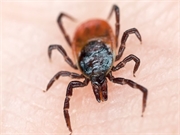SATURDAY, Aug. 1, 2020 (HealthDay News) — Summer means higher odds of getting Lyme disease, so know how to avoid it, health experts say.
Lyme disease is caused by a bacterium carried by some ticks and, if left untreated, can cause severe health problems.
Ticks can live anywhere, but they thrive in woods and damp, dark or overgrown places.
“Mow your lawn,” said Tara Simmons, a community health nurse at Penn State Health Milton S. Hershey Medical Center. “And if your kids have a play set in the backyard that borders trees, create a barrier of wood chips. Ticks will have difficulty crossing a dry, sunny area.”
When walking in meadows and the woods, stay on the paths and wear light-colored clothing, which make it easier to see ticks. You should also treat clothing and hiking gear with the insecticide permethrin, she advised.
But don’t rely on insect repellents to prevent tick bites, Simmons added.
“They’re good at keeping mosquitoes away, but they don’t kill ticks — just repel them,” she said. “Ticks may be able to walk across the sprayed skin and seek shelter in an area you missed, like an ear.”
After a hike, take everything off and wash it, or just toss it in the dryer as ticks can’t survive the heat. Then shower and check for ticks. If you wash off a tick before it’s attached, it didn’t have a chance to transmit the bacteria.
The proper way to remove a tick is with tweezers, according to the U.S. Centers for Disease Control and Prevention.
“Get the tip of the tweezers as close to the skin as possible, and as close to the tick’s head as possible and pull straight up,” Simmons said in a Penn State news release. “Don’t use a match or nail polish. These old wives’ tales are dangerous and can force the tick to burrow down further into your skin.”
If part of the tick stays in the skin, don’t panic. “You can try to dig a little to get the remaining parts of the tick out. Or you can just clean the area with soap and water or rubbing alcohol. Your body should break down the tick parts effectively,” Simmons explained.
Early symptoms of Lyme disease are like flu symptoms with fever, muscle aches, fatigue, headaches and swollen lymph nodes.
One sure symptom is a rash where you were bitten. “A bullseye rash is a telltale symptom of Lyme disease,” Simmons said. “But a rash doesn’t always appear, and when one does, it may take a different shape.”
Treating Lyme disease as early as possible, before complications develop, is essential. If you develop a bullseye rash or flu-like symptoms, see your doctor.
“If you’re unsure if you’ve been bitten, don’t have a rash and have tested negative for COVID, your doctor may test you for Lyme disease,” Simmons said.
The typical initial treatment for Lyme disease is the antibiotic doxycycline. If the disease advances, antibiotics may be given intravenously. Symptoms at this stage can include severe neck stiffness, facial palsy, arthritis, an irregular heartbeat, dizziness, nerve pain and shortness of breath.
“Once those complications start happening, damage is occurring. You’re having significant impairments,” Simmons said. The third stage of Lyme disease can develop months or years later and cause arthritis, limb numbness and neurological problems.
More information
For more on Lyme disease, head to the U.S. Centers for Disease Control and Prevention.
Copyright © 2025 HealthDay. All rights reserved.

